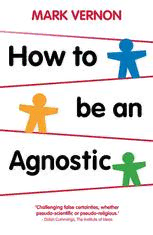
How To Be An Agnostic PDF
Preview How To Be An Agnostic
How To Be An Agnostic Also by Mark Vernon THE GOOD LIFE THE MEANING OF FRIENDSHIP PHILOSOPHY FOR THE CURIOUS ETHICS FOR THE CURIOUS PLATO’S PODCASTS: The Ancients’ Guide to Modern Living CHAMBERS DICTIONARY OF BELIEFS AND RELIGIONS (editor-in-chief) UNDERSTAND HUMANISM WELLBEING (Art of Living Series) 42: DEEP THOUGHT ON LIFE, THE UNIVERSE AND EVERYTHING WHAT NOT TO SAY: Finding The Right Words At Difficult Moments BUSINESS: The Key Concepts How To Be An Agnostic Mark Vernon © Mark Vernon 2011 All rights reserved. No reproduction, copy or transmission of this publication may be made without written permission. No portion of this publication may be reproduced, copied or transmitted save with written permission or in accordance with the provisions of the Copyright, Designs and Patents Act 1988, or under the terms of any licence permitting limited copying issued by the Copyright Licensing Agency, Saffron House, 6–10 Kirby Street, London EC1N 8TS. Any person who does any unauthorized act in relation to this publication may be liable to criminal prosecution and civil claims for damages. The author has asserted his right to be identified as the author of this work in accordance with the Copyright, Designs and Patents Act 1988. First published in paperback 2008 as After Atheism: Science, Religion, and the Meaning of Life by PALGRAVE MACMILLAN This revised edition published 2011 by PALGRAVE MACMILLAN Palgrave Macmillan in the UK is an imprint of Macmillan Publishers Limited, registered in England, company number 785998, of Houndmills, Basingstoke, Hampshire RG21 6XS. Palgrave Macmillan in the US is a division of St Martin’s Press LLC, 175 Fifth Avenue, New York, NY 10010. Palgrave Macmillan is the global academic imprint of the above companies and has companies and representatives throughout the world. Palgrave® and Macmillan® are registered trademarks in the United States, the United Kingdom, Europe and other countries. ISBN 978-0-230-29321-2 ISBN 978-0-230-30144-3 (eBook) DOI 10.1007/978-0-230-30144-3 A catalogue record for this book is available from the British Library. A catalog record for this book is available from the Library of Congress. 10 9 8 7 6 5 4 3 2 1 20 19 18 17 16 15 14 13 12 11 Transferred to Digital Printing in 2014 For Nicholas George Contents List of Illustrations ix Acknowledgements xi Introduction: There’s Something, Not Nothing 1 1. Socrates’ Quest: The Agnostic Spirit 20 2. Cosmic Religion: How Science Does God 48 3. How To Be Human: Science and Ethics 85 4. Socrates or Buddha? On Being Spiritual But Not Religious 107 5. Bad Faith: Religion as Certainty 137 6. Christian Agnosticism: Learned Ignorance 167 7. Following Socrates: A Way of Life 199 8. How To Be An Agnostic: An A–Z 226 Further Reading and References 261 Index 270 vii List of Illustrations I.1: D urham Cathedral has stood for over 900 years, ‘half church of God, half castle ’gainst the Scot’, as Sir Walter Scott put it. 7 I.2: T .H. Huxley coined the word agnosticism, and it’s one that has stuck for describing a mid-position between the certainties of atheism and theism. 14 1.1: T he ruins of Delphi, high on the slopes of the ‘Shining Cliffs’. 21 1.2: S ocrates’ ugly appearance accentuated the inner beauty of his unsettling wisdom. 42 2.1: S ir Isaac Newton – gentleman, sage, rationalist or alchemist? 50 2.2: C osmologists have always been humbled by the vastness of the universe they study. 60 2.3: T he ‘burnished and resplendent’ fly, as drawn by Robert Hooke, in 1667. 76 3.1: T he Parthenon has made the wonder of technology manifest for 2500 years. 87 3.2: A ristotle, who articulated a way of thinking about how to live known as virtue ethics. 102 4.1: C arl Gustav Jung wrote of the spiritual crisis of modern people. 112 4.2: B uddha as depicted at Kamakura, Japan. 124 5.1: S t Dominic, depicted by Fra Angelico, from the period in which the practice of prayer and the exercise of reason were indistinguishable. 148 5.2: A pophatic religion was a life-long search. Fundamentalist religion is stick-on statement. 157 ix List of Illustrations 6.1: T he greatest challenge to the intellect, according to the Socratic Nicholas of Cusa, was what he called ‘learned ignorance’. 177 6.2: I t is better to think that God is a monster than that the problem of evil can be solved – the message of Job? 188 7.1: P lato’s Academy aimed at personal transformation as well as careful understanding. 208 7.2: M ichel de Montaigne ‘assayed’ his life in the privacy of the tower of the Château de Montaigne, Périgord. 218 8.1: L eslie Stephen’s agnosticism found expression in his love of the Alps. 247 8.2: S igmund Freud’s ‘royal road’ to the unknown unconscious borrows from the Christian tradition of radical uncertainty. 251 x Acknowledgements A book like this is the product of many conversations and encounters, of many experiences and parts of life shared. Thank you and I look forward to more. In terms of producing the text in particular, I want fulsomely to thank Jeremy Carrette, Paul Fletcher and Piers Benn who have read drafts and made sugges- tions. Needless to say, all faults remaining are mine. Great thanks are also due to my sometime editor Dan Bunyard. For this new edition of the book formerly published as After Atheism – here thoroughly revised and added to throughout, including two chapters that are almost completely new and a third entirely new – thanks too to my copyeditor, Sally Daniell, to Laura Conn, Abby Coften and Melanie Blair at Palgrave Macmillan and to Pri Gibbons also at Palgrave Macmillan for championing my cause. xi
